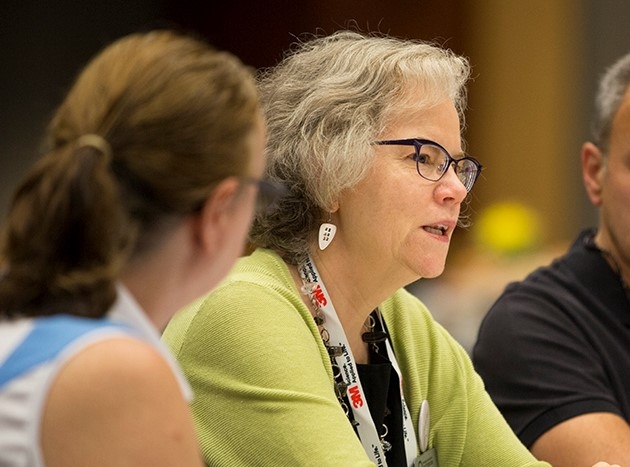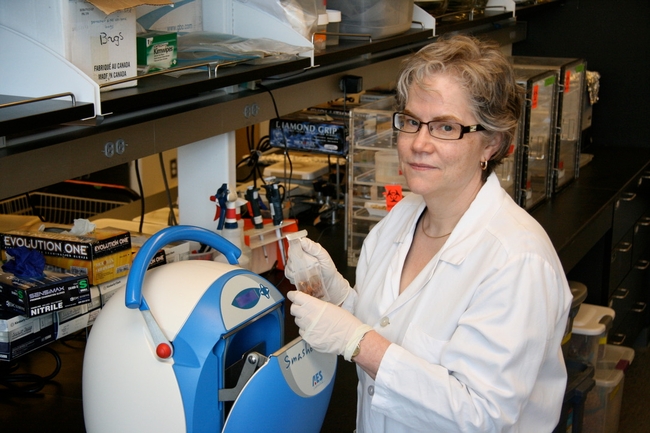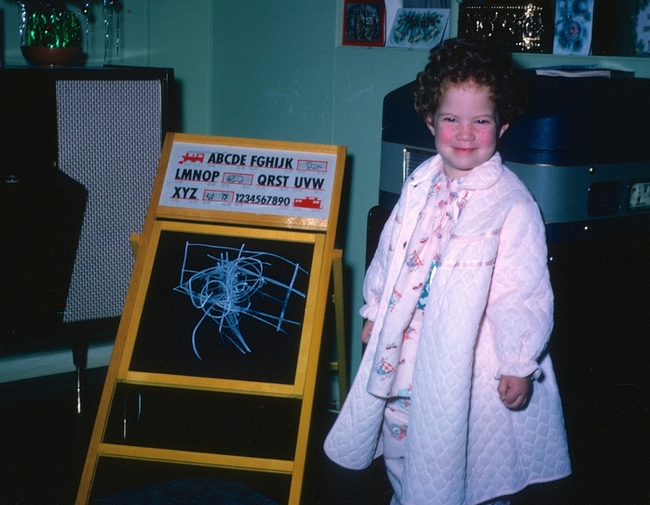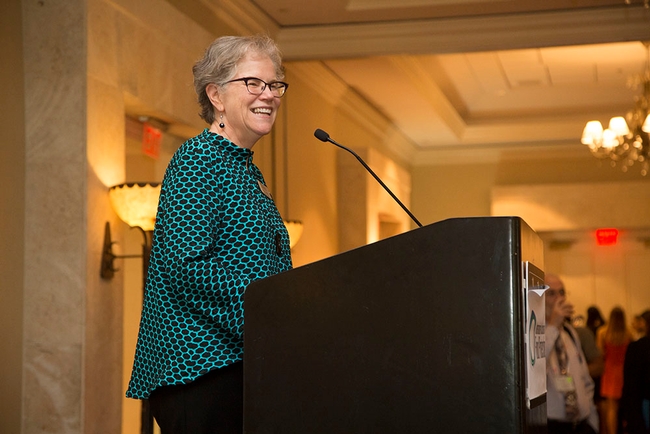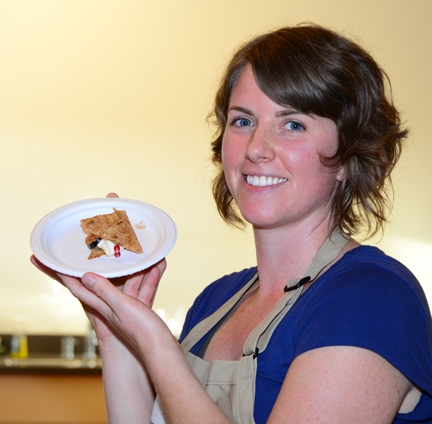Posts Tagged: food science
Five questions with food safety expert, new AAAS Fellow Linda Harris
Professor of Cooperative Extension shares career story, appreciation for UC Davis
After growing up in northern British Columbia, in a remote smelter town called Kitimat (“an 8-hour drive from the nearest McDonald's”), University of California Professor of Cooperative Extension Linda J. Harris embarked on an academic journey that crisscrossed North America and eventually led to her election as a Fellow of the American Association for the Advancement of Science.
AAAS, the world's largest multidisciplinary scientific society and publisher of the journal Science, recently announced the election of its 2021 class, which will be inducted during its annual meeting, Feb. 17-20.
In addition to Harris – a faculty member in UC Davis' Department of Food Science and Technology – four other UC Agriculture and Natural Resources affiliates will be inducted: Helene Dillard, dean of the UC Davis College of Agricultural and Environmental Sciences; Kathryn Uhrich, dean of the UC Riverside College of Natural and Agricultural Sciences; and UC Berkeley Professors Rodrigo Almeida and Paolo D'Odorico.
Harris, a Certified Food Scientist, recently shared her thoughts on the value of extension work, her contributions to the field, UC Davis' support for women in academia, and the arc of her career journey.
How did you get your start in food science and microbiology?
I was interested in science at an early age. As an undergraduate student at the University of Victoria in Victoria, B.C., I enrolled in biochemistry at the suggestion of my high school biology teacher. In my second year, I switched to the University of Alberta in Edmonton, Alberta and decided to review the course catalog – a paper version! When I got to the section on Food Science, the applied nature of the field just sounded right and I never looked back.
However, I didn't do particularly well in microbiology as an undergraduate student – too much memorization for me. At the end of my B.S. I was ready for a job in the food industry and took the very first job I was offered – ironically enough as a dairy microbiologist in a quality control lab. Thankfully, that job opened my eyes to the possibilities in microbiology. What was memorization turned into something I learned through doing and I was hooked.
Two years later, I was ready to go back to school and contacted a professor of food safety microbiology at the University of Alberta who fortunately had funding for me. During my M.S. degree in food microbiology, he encouraged me to pursue the Ph.D. – which was not something I had ever considered – and that led me to leave Canada and head to North Carolina State University and a Ph.D. in microbiology in the Food Science Department, where I worked on a project related to the fermentation of sauerkraut.
I did have one publication related to food safety during my time at NC State, and when I took my first faculty position back in Canada [University of Guelph in Ontario] I continued to work in food safety, mostly with meat and meat products.
I am so glad that I saw the advertisement for my current position and that I followed my instincts to apply for the job. The opportunities to grow professionally and to work in the food safety area at UC Davis, within the Cooperative Extension network in California, and with collaborators across the U.S., and around the world, have been enormous, and I am extremely grateful for the path that led me here.
February 11 is the United Nations-designated “International Day of Women and Girls in Science.” How has UC Davis supported women in your scientific field?
My career in STEM [science, technology, engineering and math] has been very rewarding and many of the gender barriers I faced early on have been addressed. I feel very fortunate to have landed at UC Davis and I am thankful that there is a long history of addressing these barriers at this institution.
When I was hired in 1996, the Department of Food Science and Technology was about 25% women and both the department chair and dean of the college were women. I had never been in a department or college with so many women faculty, including in positions of leadership. It was a very important consideration in my move. Today our department is 50% women and I proudly served for five years as the second woman department chair, from 2016 to 2021.
As a first-generation university graduate raised by a single mother, you have a unique perspective in encouraging young people on their path toward a STEM career. What advice do you have for them?
To those contemplating a career in STEM, I would say: be open to new opportunities and adventures – you never know where they may lead you. Get involved in leadership in any capacity you can from student organizations or around other things that interest you. Skills that you learn with these types of activities will be invaluable to your career.
I am very much an introvert and had to work hard to overcome my fear of public speaking. In addition to leadership roles in student clubs, I joined Toast Masters while working on my Ph.D. These activities had a huge impact on building my confidence and helped influence my career choices.
In the AAAS Fellows announcement, it says you were elected for “contributions to the field of food safety microbiology, especially related to control of Salmonella and other pathogens in low-moisture foods and fresh produce.” Is that your proudest achievement in the field?
I am most proud of the work described by that short statement especially as it applies to California-grown commodities. I would say that my laboratory is best known for work with the tree nut industry – almonds, pistachios and walnuts, as well as a range of types of fresh produce grown in this state.
My laboratory has worked to understand behavior, movement, prevalence, and especially control of foodborne pathogens like Salmonella during production in the field through harvest and postharvest handling all the way through to consumer practices.
I have been fortunate to have many terrific state, national and international collaborators and an outstanding group of people working in my laboratory as we set the foundation for some of the food safety research in tree nuts and produce. It has been most gratifying to watch the significant growth in these fields of investigation, especially with a new generation of scientists that span the country and beyond.
Another “hat” you wear is UC Cooperative Extension specialist. How have you contributed to food safety knowledge and practices in our communities?
I think you will see that my “hats” are not that different. The research from my laboratory has provided the foundation for several commodity-based, food-safety risk assessments – for almonds, pistachios, and walnuts. And these, in turn, have been used in support of regulations or helped guide implementation of safer food industry practices. Our research has also informed several publications aimed at consumer handling of fresh fruits and vegetables and has been cited in regulations pertaining to fresh produce safety. It is gratifying to see our research being used.
My research and extension work are very integrated. One feeds the other. Because I have been able to interact with stakeholders (especially integral to my position as a Cooperative Extension specialist), I have been able to understand firsthand some of the pressing food-safety issues and challenges in California. These stakeholder interactions have largely formed the basis for most of my research and extension grant proposals over the years. The collaborations that have resulted from extension activities have opened doors and access to many unique opportunities for sample collection and research exploration.
Mid-winter feast to celebrate bees and honey
It may be the heart of winter now, but in Central California, spring is just around the corner, bringing with it clouds of pink and white blossoms on thousands of almond trees.
And with the blossoms come the bees on which so many California crops depend for pollination.
In celebration of this vibrant time of year and the bees and beekeepers who help bring it to life, a special five-course gourmet dinner will be held Saturday, Feb. 8, at the Robert Mondavi Institute for Wine and Food Science at UC Davis.
The Mid-Winter Beekeeper’s Feast: A Taste of Mead and Honey is coordinated by the Mondavi Institute’s Honey and Pollination Center as a showcase for local, seasonal foods and a fundraiser for the center.
The dinner, which will be from 6:30 p.m. to 9:30 p.m. in the Sensory Building of the Robert Mondavi Institute, has been designed by UC Davis alumna Ann Evans using her “Davis Farmer’s Market Cookbook” and by Mani Niall, author of numerous cookbooks including “Covered in Honey” and his latest venture, “Sweet!”
Each of the five courses will feature seasonally available foods that are enhanced with varietal honeys, wines and mead. The meal will conclude with a cheese course with fresh honeycomb and a selection of mead. The mead tasting will be guided by Darrell Corti, an international wine judge.
The event will be accompanied by a musical trio and include a silent auction of gift baskets and unique food-, wine- and honey-focused opportunities.
Proceeds from the evening will benefit the Honey and Pollination Center, which coordinates educational and research efforts in support of all aspects of the beekeeping industry.
If you’re interested in joining in this celebration of the bounty of the beehive and beekeepers, visit the events section of the Robert Mondavi Institute website and look for the Mid-Winter Beekeeper’s Feast flyer and registration information, including details for purchasing either single tickets or sponsoring an entire table.
UC Davis decoding mother's milk for clues to lasting health
Is there such thing as a nutritionally perfect food? Is there something a human can consume that provides everything a body needs to stay healthy?
Yes, scientists say. Breast milk.
“Mother’s milk is the Rosetta stone for all food,” said Bruce German, professor in the Department of Food Science and Technology at UC Davis and director of the UC Davis Foods for Health Institute. “It’s a complete food, a complete diet, shaped over 200 million years of evolution to keep healthy babies healthy.”
German and his team are now decoding breast milk to better understand its components and why they work so well. They are discovering a wealth of information about how best to feed and protect the human body, lessons that will enhance health not just for infants but for us all.
What are they learning?
For one thing, a large part of breast milk goes into babies' mouths and out into their diapers with no digestion along the way. That's astonishing. Of the 500 calories a lactating woman burns each day to make milk, 10 percent is spent synthesizing something the baby treats as waste. If it didn’t have value to the developing baby, wouldn’t natural selection have discarded it long ago?
Turns out, it has great value. The indigestible matter is a slew of sugar polymers called oligosaccharides that feed specific bacteria in a baby’s gut. The oligosaccharides help good bugs proliferate and dominate, keeping babies healthy by crowding out the less savory bugs before they can become established and, perhaps more important, nurturing the integrity of the lining of an infant’s intestines, which play a vital role in protecting them from infection and inflammation.
“What a genius strategy,” German said. “Mothers are recruiting another life form to babysit their babies.”
So maybe when we nourish our bodies, we should think about feeding our good bugs, too.
How do we do that? Good question. Scientists can’t yet say for sure what a healthy bacterial community in our guts should look like, let alone how best to promote it. But one thing is certain, German says.
“Our good bacteria play a much more important role in our health than we realized,” German said.
So oligosaccharides might support microbial balance in our digestive tracts. Nursing babies can get them from their mothers. What about the rest of us?
Another good question, and UC Davis researchers are on it, identifying, extracting and delivering health-promoting oligosaccharides from various sources, including whey, the waste product from cheese making.
You can read all about it (and more) in this story on the UC Davis College of Agricultural and Environmental Sciences website: http://caes.ucdavis.edu/news/articles/2013/09/title-uc-davis-decoding-mother2019s-milk-for-clues-to-lasting-health
Pomegranates, figs and honey!
California produces more figs and pomegranates than any other state in the nation; in fact, our state is the sole producer of 99 percent or more of the U.S.-grown pomegranates and figs, according to the California state office of USDA's National Agricultural Statistics Service.
And honey? The Golden State ranks second in honey production, eclipsed only by North Dakota.
So why not combine all of them into a dessert? And add some walnuts and goat cheese for good measure--and good taste?
That’s exactly what Julie Loke of the Davis Food Co-Op did at the debut event of the newly established Honey and Pollination Center of the Robert Mondavi Institute for Wine and Food Science (RMI) at UC Davis.
The event, held Oct. 27 in the RMI’s Silverado Vineyards Sensory Theatre, drew talks on honey and pollination, and showcased a bee observation hive from the Harry H. Laidlaw Jr. Honey Bee Research Facility.
The Honey and Pollination Center, approved earlier this year by the UC Davis College of Agricultural and Environmental Sciences, aims to “make UC Davis the nation’s leading authority on honey, honey bees and pollination by combining the resources and expertise of RMI and the Department of Entomology’s Harry H. Laidlaw Jr. Honey Bee Research Facility,” said RMI executive director Clare Hasler-Lewis.
The center's goals include:
- Expand research and education concerning nutrition, health, quality and appreciation of honey
- Develop useful information for California’s agricultural bounty that depends on insect pollination
- Help the honey industry establish labeling guidelines to guarantee pure and unadulterated varietal honey
- Coordinate a multidisciplinary team of experts in honey production, pollination and bee health
- Promote the use of locally procured honey in the home, food industry and restaurants
Loke, the Davis Co-Op Teaching Kitchen coordinator, says she’s been obsessed with food for as long as she can remember. With 10 years of experience following “foodie adventures” (her repertoire includes running a kitchen on an eco-cruise, working in an organic garden, and teaching kids how to cook from scratch), she now teaches cooking classes at the Davis Co-Op, where she works full-time doing marketing, education and events.
The pomegranate is one of her favorite new foods.
“I’m from the East Coast and Midwest and had very little exposure to them growing up,” she said. “I love the act of breaking open the skin and having the arils (the juicy seeds) pop out, like a beautiful present! I love to eat them just out of hand but have incorporated them in everything from grains with toasted almonds to tossing them in most any salad and especially in desserts for a fun pop of tartness."
So when Loke delivered her presentation on how to make Baklava-Inspired Napoleans with fresh figs, pomegranate, honey and chevre mousse - and then served the dessert to the crowd - the crowd clamored for more.
This pastry serves 6 to 8 people, but “depending on how you cut the baklava and how much mousse you use, it could feed even more,” Loke says. She describes it as "crispy layers of phyllo dough, walnuts and spices, balanced atop dollops of tangy goat cheese mousse with fresh local figs, drizzled in California orange blossom honey."
Baklava Inspired Napoleans with Fresh Figs, Pomegranate, Honey and Chevre Mousse
Ingredients:
1/2 stick of butter
10 sheets whole wheat phyllo dough, thawed
10 fresh figs, sliced into thinnish rounds or thin wedges, tossed in a little thinned honey
2 cups chevre mousse (see recipe below)
1/4 cup honey, such as Moonshine Trading Company’s California orange blossom
1 cup finely chopped raw walnuts or pistachios
1/2 cup raw sugar
1 teaspoon cinnamon
1/4 teaspoon nutmeg
1/4 teaspoon allspice
Directions:
Thaw phyllo dough in the refrigerator overnight. Pre-heat oven to 400 degrees. You can melt the butter in the preheating oven or in short bursts in the microwave or in a pan on the stove—watch it closely. Set aside in a warm spot on the stove.
In a food processor, finely mince the nuts, sugar and all of the spices. It should be fairly fine easy to sprinkle over the dough. Or chop by hand and mix. Set aside. This will be layered between each sheet of phyllo dough. Prepare two sheet pans that are large enough to hold the phyllo sheets or close to it; you can always trim the phyllo to fit. Gently unwrap the phyllo and cover with a clean, damp fuzz-free dishtowel. Lift a whole sheet of phyllo from the pile and carefully lay out over the sheet pan. Replace the damp dishtowel over the pile. Using a pastry brush, lightly butter the first layer and lightly sprinkle with the spiced nut filling. Repeat and continue until you’ve done 4 sheets. Now carefully cut into 4-inch x 4-inch squares, or any other size or shape you can imagine. Then repeat the whole process on the other pan. Place into a 400 degree oven for about 10 minutes, or until golden brown and flaky. Let cool and then using your figs, honey and chevre mousse, layer into little towers. Drizzle all over with honey.
Chevre Mousse
1/2 cup heavy cream
1/4 cup goat cheese (chevre), room temperature
1 teaspoon pure vanilla extract and/or orange zest
2 tablespoons sugar
In a mixing bowl, whip the goat cheese with the whisk attachment until it starts to soften. Add the cream and orange zest and continue mixing until soft peaks just begin to form. Be careful you don’t overheat.
(Editor's note: If a pomegranate perplexes you, Julie Loke will be teaching a short introductory class on pomegranates at 6 p.m. Wednesday, Jan. 9, in the teaching kitchen of the Davis Food Co-op. She’ll show folks how to select, cut open, and juice pomegranates, and she'll provide a few recipes as well. The cost is $7. See http://davisfood.coop/education/cookingclasses.)

California is the sole producer of 99 percent of the pomegranates grown in the United States. (Photo by Kathy Keatley Garvey)

This bee observation hive from the Harry H. Laidlaw Jr. Honey Bee Research Facility was showcased at the Honey and Pollination Center event. (Photo by Kathy Keatley Garvey)

Close-up of Baklava-Inspired Napoleans. (Photo by Kathy Keatley Garvey)

